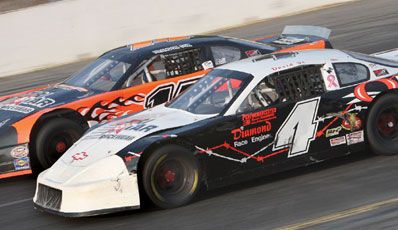
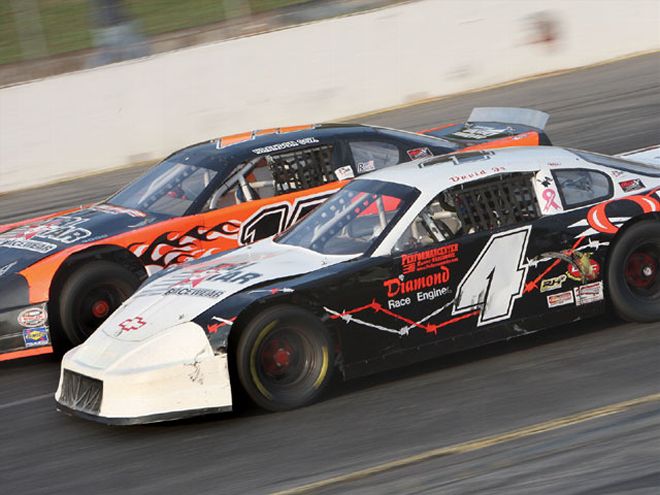 The racing is tight and you are looking for anything you can do to give yourself an advantage down the stretch. Here are some ideas.
The racing is tight and you are looking for anything you can do to give yourself an advantage down the stretch. Here are some ideas.
The season is winding down. With only a handful of races left, you are looking to make one final push in the standings. Or maybe you have yet to win a race this season and are willing to take a few more chances than before to finally grab that brass ring. After all, you almost certainly will have the engine refreshed during the off-season, so if there was ever a time to gamble this is it, right?
With that in mind, here are 10 tips for squeezing out a little more power from your race engine. Not every tip is guaranteed to apply to you, but they can help you get the wheel turning for other ideas to bump up the power for the last few races.
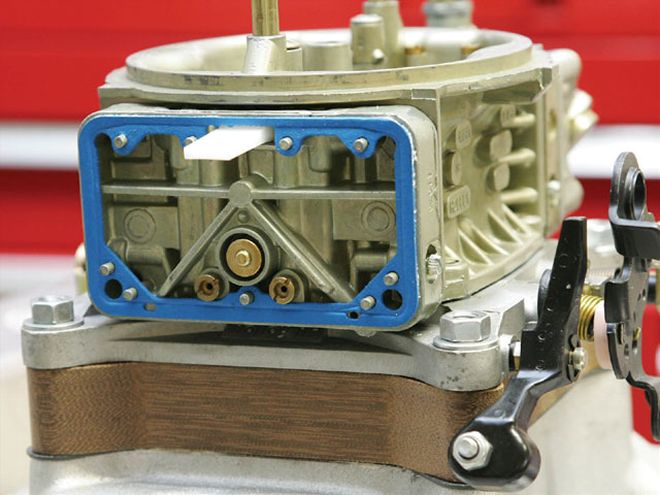 Late in the season, the cooler weather can allow you to make a jetting change to make more power.
Late in the season, the cooler weather can allow you to make a jetting change to make more power.
RESET THE JETS
We may not think about it much, but race cars are quite temperature sensitive. This can be a pain in the summertime when the track feels slick and the car is constantly on the edge of overheating, but as the temperatures cool toward the end of the season, it is time for you to take advantage.
One way to do this is by taking a look at your carburetor jetting. Typically, in the early fall the air not only cools down, but also loses humidity. You may find that the carburetor jet settings that worked well for you in July are now a little too lean. This is because the cooler air is denser and more of it is flowing through the venturis. You may find that you can actually coax more power out of your engine by fattening up the jets a little bit.
SLOW THE FLOW
If you are running a stock-size water pump pulley on your race engine, you should be able to free up a horsepower or two by running an oversized race pulley, a smaller crankshaft pulley, or a combination of the two. The resized pulleys will slow down the water pump's impeller. Since the pump is not trying to push coolant through the block's water jackets as quickly, less power is required. Stock-style water pumps are designed to flow enough water through the engine to keep it at proper operating temperature after long periods at idle. This is a good idea when you are sitting in traffic trying to get home from work, but it really isn't necessary on your race car. At racing rpm levels, the typical pump is trying to push way too much volume. Also, race-quality pulleys are usually constructed from aluminum, and even though the pulley may be larger than stock, it will still have much less rotating weight than the stock stamped-steel pulley.
Also, if you are running a flow restrictor in your water neck, get rid of it immediately. The idea behind the restrictor is to slow the movement of coolant through the engine to allow it to draw more heat. But the combination of a restriction to water flow and a fast-spinning water pump is not only a big drain on power, but also the cause of pump cavitation, which aerates the coolant and destroys the system's efficiency. Furthermore, the speed the coolant travels through the engine really has no effect on overall temperatures.
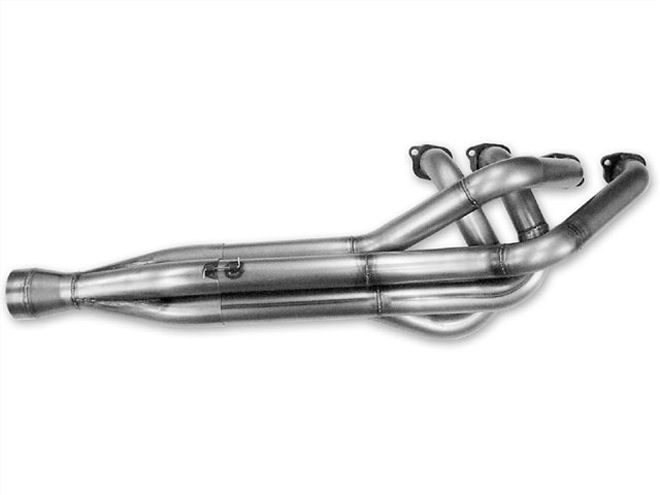 Esslinger Engineering is now offering Mini-Stock racers a three-step header that is designed for Midget racing and capable of producing significant power gains over most other headers out there.
Esslinger Engineering is now offering Mini-Stock racers a three-step header that is designed for Midget racing and capable of producing significant power gains over most other headers out there.
INTELLIGENT BOLT-ONS
Toward the end of the season, many racers begin planning the upgrades they will make to their race car during the off-season. Esslinger Engineering's Cary Maruyama believes that instead of waiting, this may be the perfect time to spend a few bucks wisely on products that will help you this season and next.
"Usually you can do a couple of bolt-on pieces here or there that will help you more than anything else," he says. "At Esslinger we specialize in Ford four-cylinder engines, so that is where my experience lays, but some of these will work with any engine.
"A windage tray is an easy upgrade if you don't already have one. It just bolts to the main caps, and they can literally gain you over 10 hp. That's about the best bang-for-the-buck that you are going to find anywhere and it doesn't require tearing into the engine.
"On the Ford four-cylinders, we can help guys pick up some serious horsepower quickly by upping the compression. A lot of times, if a guy is only running 10:1 compression and racing with 110-octane race fuel, we can take him up to 12.5:1 easily by shaving the cylinder head. I've found a lot of times guys won't have as much compression as they think they do. They won't know the cc's of the valve reliefs in the pistons, the thickness of the head gaskets, and other things like that. If we find they can use more compression, they can send us their cylinder head and we'll take care of it for them. The Ford head is an overhead cam configuration, so you can cut the deck and put it back on without worrying about screwing up the valvetrain geometry.
"Finally, I believe a lot of guys are sleeping on their headers. They've bought something out of a catalog, bolted it on, and not thought much else about it. We have one header that we developed out of the Midget program. We've flanged it up for a stock Ford four-cylinder head and found as much as 13 hp in many applications. It is a stepped header that goes from 151/48 inches to 131/44, to 171/48, and it really builds the power in these engines.
"Also, you can gain power where you need it by putting some thought into the pipe you are running from the header out. I'm talking about the exhaust pipe that runs from the header collector to the exit of the car. The longer that pipe is, the more low-end power you are going to gain. If the pipe is shorter, it will move the powerband higher in the rpm range. Generally, the pipe should be between 3 and 4 feet. I know we have customers that will change the length of the pipe depending on the track they will be racing. If it is a small track with tight turns, they will run a longer pipe. If the track is bigger with sweeping turns, they will shorten it up."
DEPEND ON THE BATTERY
Just like the water pump, an alternator is a drain on the engine's power. In many cases it is necessary because it continually recharges the battery, which enables the ignition to provide an adequate spark to the combustion chambers over the course of a long race. But if you are running 10- to 20-lap features, you may be able to get by without an alternator.
You can get away with running short features without an alternator, but you'll have to charge the battery before every race to make sure it is at full power. To have an additional safeguard against battery failure, install two lightweight batteries, such as those made by Dyna-Batt. Two of these weigh as much as a regular store-bought one and you'll always have a backup. Often, racers find that it isn't worth the trouble because forgetting to charge the battery means being significantly down on power by the end of a race. But if you are looking for every advantage for the last race or two of the season, ditching the alternator might be worthwhile.
ELECTRIC COOL
Electric Cool At the beginning of this article, we stated that you will need to pick and choose which of these tips will work for you. Some of these tips won't work well together, and this one is an example that definitely clashes with the idea of ditching your alternator.
Switching out a mechanical radiator fan bolted to the end of the water pump for a fan powered by an electric motor can potentially save you several horsepower. Using a fan attached to the motor to pull in air through your radiator is a big drain on power, and the higher the rpm, the greater the drain. You can think of an electric radiator fan as an additional engine under your hood. The only drain on horsepower is the added load on the alternator, but this is much less than the drain caused by a spinning radiator fan. Generally, an electric fan placed behind the radiator (called a "puller") is more efficient than an electric fan placed in front of the radiator designed to push the air through. This is because the electric motor in the center of the "pusher" fan blocks some air trying to get to the radiator.
This tip will not work with our previous tip (ditching the alternator) because an electric radiator fan places an additional load on your race car's electrical system. Powering the ignition system and an additional electric motor at the same time for an entire race is simply too much for a car battery. In our experience, if you are currently running both an alternator and a mechanical fan, keeping the alternator and adding an electric radiator fan in place of the mechanical unit is definitely the way to go.
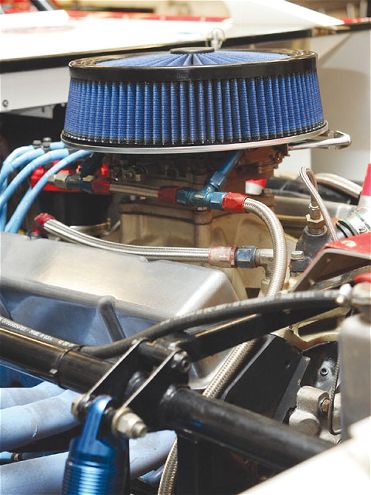 Oiled-gauze air filters are the best and offer the most protection for your engine, but they can cut airflow to your engine if not properly maintained.
Oiled-gauze air filters are the best and offer the most protection for your engine, but they can cut airflow to your engine if not properly maintained.
FAST-FLOW FILTERS
We all know that oiled cotton-gauze filters work better than the cheap paper filters sold at discount auto parts stores, but oiled filters don't last forever, either-especially if they aren't properly maintained.
"You might not believe this, but I found over 100 hp once by changing the air filter," says engine builder Dennis Wells of Wells Racing Engines in Duncanville, Texas. "That was a worst-case scenario, but it can happen. The guy who owned the car knew the engine was down on power, but he couldn't figure out why. He had already changed the carburetor, the distributor, plugs and wires, just about everything you can think of, before he brought it to me."
"I put it on the dyno and it did the same thing until I took the filter assembly completely off, and then it picked right back up. He had been washing his filter with dishwashing liquid, which is a big mistake. You have to use the cleaner made for those filters. Using dishwashing liquid or hand soap causes that material to mat up, and it won't flow air. When you take care of those filters properly, they will last a long time. But if you have had yours for a while, you might be able to pick up a little power by replacing your old filter with a new one."
GO THINNER
Thin is in when it comes to motor oils. Modern synthetic blends have made it safe to use thinner motor oils than ever before. With a well-built race engine, most engine builders feel that a 20W-50 motor oil can provide more than adequate protection. But many Cup teams regularly push the limits with ultra-low-viscosity oils because there is power to be found there. Of course, Cup teams can also afford to rebuild their engines after every race, unlike most of us. But if the season is wrapping up and you know you are going to have to spring for a rebuild anyway, trying an ultra-light motor oil is no longer such a big gamble.
The same thing holds true for your transmission fluid and even the gear lube you are running in your rearend. Lighter oil in any of these three places should translate directly into more power being transferred to the ground. You just have to determine how thin you are willing to go.
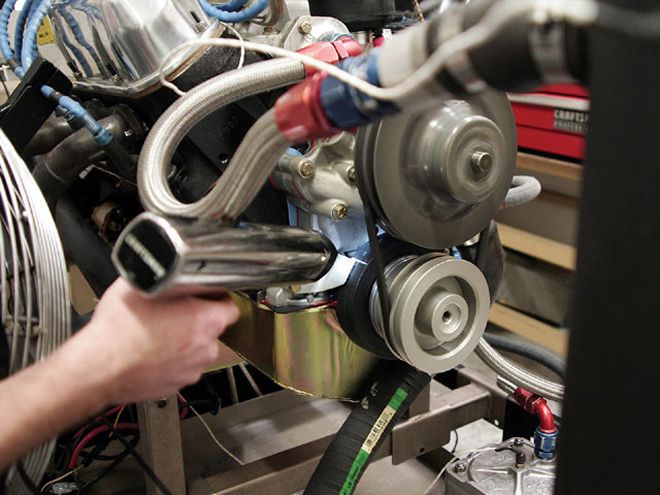 With stock cylinder heads, you can sometimes find more power by advancing the timing a couple of ticks. But you will have to be constantly vigilant for detonation.
With stock cylinder heads, you can sometimes find more power by advancing the timing a couple of ticks. But you will have to be constantly vigilant for detonation.
FLIRT WITH DETONATION
In the lower-level racing classes, where stock or stock-style cylinder heads are the rule, proper ignition timing is almost always about finding maximum power before costly detonation becomes an issue. If you are running a nice set of aftermarket cylinder heads with efficient combustion chamber designs, this tip may not be helpful because your motor may not need as much timing advance to make maximum power. But with stock-style heads you can usually make a little more power by advancing the ignition timing an additional degree or two. And since we are talking about end-of-season power tips, the lower air temps you are likely to see can also help ward off detonation. Just don't assume that advancing the timing will always make more power. If you do not have access to a chassis dyno, spend a little track time seeing just how far you can go with your ignition timing before detonation sets in-and how those changes affect your lap times.
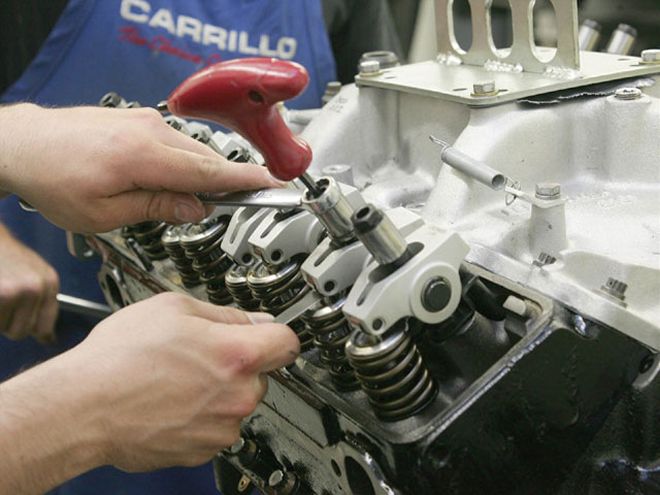 Tightening up the valve lash can make the camshaft act bigger.
Tightening up the valve lash can make the camshaft act bigger.
RE-LASH
If you are running solid lifters, you can try setting your valve lash a little tighter. Tightening up the lash by 0.001 or 0.002 inch will allow the camshaft to activate the valves sooner, essentially fooling the engine into acting like it has a larger cam in there. Sometimes this will help produce power, but if the best camshaft possible is already in your engine, closing up the lash will only make it more sluggish.
This means that you will have to do a little experimenting to determine if closing up the lash will be helpful or not. Also, if you have been adjusting lash with the engine cold, you will need to find out how much the lash changes when the engine gets hot. What you must avoid is closing up the lash so much that the valves never fully seat and, as a result, do not seal off the combustion chamber completely.
LIGHTEN UP
The next time you have the car on jackstands, take inventory of your entire driveline-from the crankshaft back. Are there any components between the flywheel and the brake rotors that can be lightened up? For example, switching from a stock-style flywheel and clutch to lightweight racing components can shave 10 pounds or more of rotating weight. The same thing goes for using an aluminum driveshaft instead of the stock chunk of steel the factory uses. The more mass the engine has to spin in order to get the wheels turning, the more horsepower that gets absorbed before it can do any good.
Technically, this tip doesn't help your engine produce more power, but it does ensure that your engine is able to efficiently transfer the power produced to the ground. And if it translates into faster lap times, all the better.
Well, there you have it - 10 tips that will hopefully help you add that extra oomph you need to grab that title or capture that first win.
AND ONE FOR THE ROAD
Just in case you felt shafted by one of these tips, here's an extra:
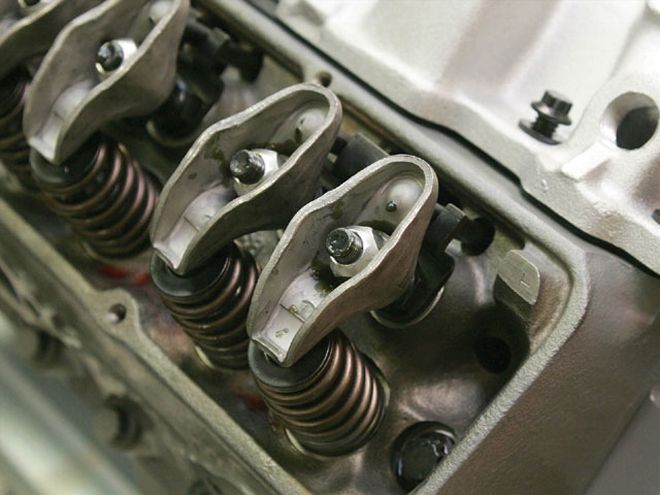 These stamped-steel rockers look like stock 1.5:1 Chevrolet units, but they are actually 1.6:1 rockers from Crane. It isn't much, but it is definitely worth power if you are racing in a class with a limit on maximum cam lift.
These stamped-steel rockers look like stock 1.5:1 Chevrolet units, but they are actually 1.6:1 rockers from Crane. It isn't much, but it is definitely worth power if you are racing in a class with a limit on maximum cam lift.
If you are running in a Street Stock class, rules usually require stock rocker arms. On a Chevrolet, for instance, the stock rocker ratio is 1.5:1, but several companies, such as Crane Cams, produce higher-ratio rockers that are virtually indistinguishable from their stock counterparts. Crane produces a 1.6:1 rocker. While that may not sound like a big change, it can usually produce a little extra power with the same camshaft. Also, the increase in rocker ratio isn't so much that it will cause piston-to-valve clearance issues.
Increasing rocker ratios in other higher-level classes is also an option. A new set of rockers isn't terribly expensive, and changing them doesn't require tearing into the engine. Just don't try to make an extreme change. If you do, you may run into problems such as requiring a change in pushrod length, clearance issues for the pushrod holes in the cylinder heads, or even spring failures. Also, make sure to recheck your piston-to-valve clearance. You should have 0.080 between the intake valve and the top of the piston at 10 degrees after TDC. For the exhaust, you should have at least 0.100 between the valve and piston at 10 degrees before TDC for that cylinder.